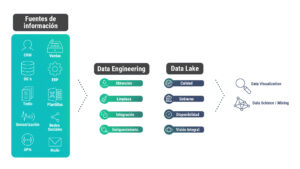In this article, we present a video where you will find everything you need to understand about the first steps in Databricks and start working with this technology for free.
Databricks for Data Analysis
Databricks has become a fundamental tool for working in Data & AI because it significantly reduces the stack of tools that anyone working with data uses. It eliminates the complexity associated with using multiple technologies because it centralizes access, manipulation, and management of data in the same place, regardless of the profile of the user (engineers, scientists, analysts, business users, etc.).
Additionally, it introduces the concept of lakehouse which came to solve the classic problems of the data warehouse and the data lake. Lakehouse architectures combine the best of both worlds: on one hand, the cost-effective storage strategy and flexibility of the data lake, and on the other hand, the performance and data availability of the data warehouse.
First Steps
In this video, we explain how modern data architectures have evolved: data warehouse, data lake, and lakehouse. We also discuss what new features and benefits Databricks introduces to people who work with data, and we review some of the most notable features: Delta Live Tables, Delta Sharing, Unity Catalog, and Databricks SQL.
This video will be useful for those who are starting to work with Databricks or need to understand the basic aspects of this tool.
In the video, you will find:
- Components of a data architecture.
- What we look for in a data architecture.
- How to build a data architecture.
- What a data warehouse is.
- Problems with the data warehouse.
- What a Data Lake is.
- What distributed systems are and how they work (Spark).
- What Databricks is.
- How to sign up for the free version (Databricks Community).
- Databricks for different data roles.
- How to structure a data lake in Databricks (Medallion architecture).
- Problems with the data warehouse and data lake.
- Data Lakehouse: what it is and what it solves.
- What new features Databricks introduces in the data lakehouse.
- Challenges of Delta Lake.
- Delta Lake: what it is and how it is composed.
- Delta Lake demo.
- Delta Live Tables: what it is and how it works.
- Delta Sharing: what it is and how it works.
- Unity Catalog: what it is and how it works.
- Databricks SQL: what it is and how it works.
What are the main advantages of Databricks?
1) Simplicity
Databricks operates as a distributed system that can be configured very simply. With just one click, we can have the computing power of a Spark cluster.
2) Power and Elasticity
The simplicity of Databricks does not come at the expense of its power. Behind this platform, we implement a system with the capacity and power of Spark, which is also 100% cloud-based. Therefore, despite being simple, it does not lose computing capacity or power.
3) For All Data Profiles
Being easy to use, having high computing capacity, and being elastic, Databricks is a platform that serves for everything we want to create with data and for all types of profiles.
4) Based on an Open Architecture
Its architecture is based on open source components. This does not mean it is free; it means that vendor lock-in is low. Suppose we need to build a data lake with terabytes and terabytes of data representing the reality of our business. The fact that it is based on open components means that if we want to move from Databricks to another technology in the future, we can do so, and the cost will not be as high.
What is a data architecture?
A data architecture is a combination of technologies that allows an organization to meet its information needs. For example: how much was sold, how many customers were gained or are at risk of being lost, what is the stock level of products, etc. It provides all the data the business needs to make data-driven decisions.
Data architecture is the technological structure behind a data solution, whether it be dashboards, reports, alert systems, artificial intelligence models, etc. The most important thing is that it can guarantee a comprehensive view of the business.
If you want to delve deeper into this concept, we invite you to read this article on What is a modern data architecture?

Conclusion
In a short time, Databricks is moving from being aspirational to becoming the chosen technology to bring Data & AI projects to life. Learning to use it is a key step for the various profiles that work with data, which is why we have provided this video with everything necessary to get started.






